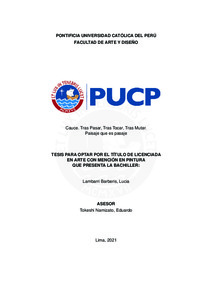| dc.contributor.advisor | Tokeshi Namizato, Eduardo | |
| dc.contributor.author | Lambarri Barberis, Lucía | |
| dc.date.accessioned | 2021-10-01T18:37:32Z | |
| dc.date.available | 2021-10-01T18:37:32Z | |
| dc.date.created | 2021 | |
| dc.date.issued | 2021-10-01 | |
| dc.identifier.uri | http://hdl.handle.net/20.500.12404/20526 | |
| dc.description.abstract | Este trabajo narra el proceso de concepción y ejecución de mi propuesta de
fin de carrera: Cauce, una obra procesual contenedora simbólica y material, a
través del dibujo, de mi existencia metaforizada en un río. Ésta atravesó distintas
etapas y conforme su recorrido traspasó, trastocó y transmutó en su interacción
con el territorio. Tras Pasar vino a ser el recorrido mismo, el acto de caminar como
parte de la obra. Tras Tocar, el acto de “sentir” el territorio, verse afectado por
él, del mismo modo en que éste es afectado. Tras Mutar, con la transformación
y permeabilidad al cambio. Para su ejecución, se recurrió a medios como la
instalación, la fotografía y las intervenciones directas en el entorno. Se trata de
una investigación que se realiza en y a través de la práctica artística. Hundiendo
sus raíces en una profunda inquietud existencial, revisa conceptos como belleza,
muerte, vacío, naturaleza y paisaje a través de las meditaciones de François
Cheng, la concepción organicista del universo del pensamiento chino y la
correlación con su pintura de paisaje, la teoría del arte como aquello que ordena el
vacío del psicoanálisis lacaniano y una revisión general del concepto y la historia
del paisaje en Occidente. Asimismo, analiza y describe obras precedentes y
fundamentales para Cauce, para finalmente desarrollarlo ampliamente. El eje
central de la propuesta, muestra que los acontecimientos del exterior, tienen
respuesta inmediata y paralela en el mundo interior del individuo. Así, se entabla
un diálogo entre un “paisaje exterior” y un “paisaje interior”, el cual es entendido
como aquellas emociones desbordadas y cuestionamientos materializados a
través del dibujo. Resalta también, la concepción del vacío como aquel “posible
lugar” para que el arte pueda ser una eficaz herramienta para lidiar con lo
indecible de la existencia. | es_ES |
| dc.description.abstract | This work narrates the process of conception and accomplishment of my degree´s
final project: Cauce, a work-in-progress artwork which contains in a symbolic
and material way, through drawing, my existence metaphorized in a river. Cauce
went through different stages and as its journey transgressed*, disrupted* and
transmuted* in its interaction with the territory. Transgressing o After passing*
was the journey itself, the act of walking as part of the artwork. Disrupted o After
touching*, the act of “feeling” the territory, being affected by it, in the same way that
it is affected. Transmuted or After changing*, with transformation and permeability
to change. Means such as installation, photography and direct interventions in the
environment were also used for its execution. Moreover, this proposal is a research
that is carried out in and through artistic practice. Sinking its roots in a deep
existential concern, it revises concepts such as beauty, death, void, nature and
landscape through the meditations of François Cheng, the organicist conception
of the universe of Chinese thought and its correlation with their landscape painting,
the theory of “art as that which orders the void” of Lacanian psychoanalysis and a
broad review of the concept and history of landscape in the West. In the same way,
it analyses and describes previous and fundamental works for Cauce, to finally
explain it widely. The central axis of the proposal shows that external events have
an immediate and parallel response in the individual’s inner world. Thus, a dialogue
is established between an “exterior landscape” and an “interior landscape”,
which is understood as those overflowing emotions and questions materialized
through drawing. It also highlights the conception of void as that “possible place”
so that art can be an effective tool to deal with the unknowns of existence. | es_ES |
| dc.language.iso | spa | es_ES |
| dc.publisher | Pontificia Universidad Católica del Perú | es_ES |
| dc.rights | info:eu-repo/semantics/openAccess | es_ES |
| dc.rights.uri | http://creativecommons.org/licenses/by/2.5/pe/ | * |
| dc.subject | Pintura de paisajes | es_ES |
| dc.subject | Naturaleza en el arte | es_ES |
| dc.subject | Psicoanálisis y arte | es_ES |
| dc.title | Cauce. Tras Pasar, Tras Tocar, Tras Mutar. Paisaje que es pasaje | es_ES |
| dc.type | info:eu-repo/semantics/bachelorThesis | es_ES |
| thesis.degree.name | Licenciado en Arte con mención en Pintura | es_ES |
| thesis.degree.level | Título Profesional | es_ES |
| thesis.degree.grantor | Pontificia Universidad Católica del Perú. Facultad de Arte y Diseño | es_ES |
| thesis.degree.discipline | Arte con mención en Pintura | es_ES |
| renati.advisor.dni | 06048049 | |
| renati.advisor.orcid | https://orcid.org/0000-0001-5394-4513 | es_ES |
| renati.author.dni | 70098427 | |
| renati.discipline | 213276 | es_ES |
| renati.juror | Migliori Figueroa, Norma Giuliana | es_ES |
| renati.juror | Tokeshi Namizato, Eduardo | es_ES |
| renati.juror | Jaime Carbonel, Alejandro | es_ES |
| renati.juror | Oblitas Jordán, Raura Raquel | es_ES |
| renati.juror | Tabja Belloso, Gianine | es_ES |
| renati.level | https://purl.org/pe-repo/renati/level#tituloProfesional | es_ES |
| renati.type | https://purl.org/pe-repo/renati/type#tesis | es_ES |
| dc.publisher.country | PE | es_ES |
| dc.subject.ocde | https://purl.org/pe-repo/ocde/ford#6.04.04 | es_ES |






